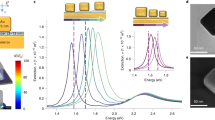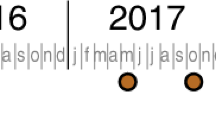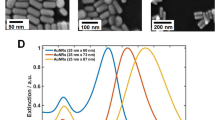Abstract
The detection of a few molecules in a highly diluted solution is of paramount interest in fields including biomedicine, safety and eco-pollution in relation to rare and dangerous chemicals. Nanosensors based on plasmonics are promising devices in this regard, in that they combine the features of high sensitivity, label-free detection and miniaturization. However, plasmonic-based nanosensors, in common with general sensors with sensitive areas on the scale of nanometres, cannot be used directly to detect molecules dissolved in femto- or attomolar solutions. In other words, they are diffusion-limited and their detection times become impractical at such concentrations. In this Article, we demonstrate, by combining super-hydrophobic artificial surfaces and nanoplasmonic structures, that few molecules can be localized and detected even at attomolar (10−18 mol l−1) concentration. Moreover, the detection can be combined with fluorescence and Raman spectroscopy, such that the chemical signature of the molecules can be clearly determined.
This is a preview of subscription content, access via your institution
Access options
Subscribe to this journal
Receive 12 print issues and online access
$209.00 per year
only $17.42 per issue
Buy this article
- Purchase on Springer Link
- Instant access to full article PDF
Prices may be subject to local taxes which are calculated during checkout






Similar content being viewed by others
References
Michaels, A. M., Nirmal, M. & Brus, L. E. Surface enhanced Raman spectroscopy of individual rhodamine 6G molecules on large Ag nanocrystals. J. Am. Chem. Soc. 121, 9932–9939 (1999).
Stöckle, R. M., Suh, Y. D., Deckert, V. & Zenobi, R. Nanoscale chemical analysis by tip-enhanced Raman spectroscopy. Chem. Phys. Lett. 318, 131–136 (2000).
De Angelis F. et al. A hybrid plasmonic–photonic nanodevice for label-free detection of a few molecules. Nano Lett. 8, 2321–2327 (2008).
Schuller, J. A. et al. Plasmonics for extreme light concentration and manipulation. Nature Mater. 9, 193–204 (2010).
Sheehan, P. E. & Whitman, L. J. Detection limits for nanoscale biosensors. Nano Lett. 4, 803–807 (2005).
Nair, P. R. & Alam, M. A. Performance limits of nanobiosensors. Appl. Phys. Lett. 88, 233120 (2006).
Lassiter, J. B. et al. Close encounters between two nanoshells. Nano Lett. 8, 1212–1218 (2008).
Fatemeh, E . et al. Nanoholes as nanochannels: flow-through plasmonic sensing. Anal. Chem. 81, 4308–4311 (2009).
Luo, M. S. C. et al. Artificial lotus leaf by nanocasting. Langmuir 21, 8978–8981 (2005).
Reyssat, M., Pépin, A., Marty, F., Chen, Y. & Quéré, D. Bouncing transitions on microtextured materials. Europhys. Lett. 74, 306–319 (2006).
Accardo, A. et al. In situ X-ray scattering studies of protein solution droplets drying on micro- and nanopatterned superhydrophobic PMMA surfaces. Langmuir 26, 15057–15064 (2010).
McHale, G., Shirtcliffe, N. J. & Newton, M. I. Super-hydrophobic and super-wetting surfaces: analytical potential? Analyst 129, 184–187 (2004).
Mahadevan, L. & Pomeau, Y. Rolling droplets. Phys. Fluids 11, 2449–2454 (1999).
Aussillous, P. & Quéré, D. Liquid marbles. Nature 411, 924–927 (2001).
McHale, G., Aqil, S., Shirtcliffe, N. J., Newton, M. I. & Erbil, H. Y. Analysis of droplet evaporation on a superhydrophobic surface. Langmuir 21, 11053–11060 (2005).
Grand, J. et al. Role of localized surface plasmons in surface-enhanced Raman scattering of shape-controlled metallic particles in regular arrays. Phys. Rev. B, 72, 033407 (2005).
Stockman, M. I. Nanofocusing of optical energy in tapered plasmonic waveguides. Phys. Rev. Lett. 93, 137404 (2004).
Chen, X. W., Sandoghdar, V. & Agio, M. Highly efficient interfacing of guided plasmons and photons in nanowires. Nano Lett. 9, 3756–3761 (2009).
Lindquist, N. C., Nagpal, P., Lesuffleur, A., Norris, D. J. & Oh, S. H. Three dimensional plasmonic nanofocusing. Nano Lett. 10, 1369–1373 (2010).
Genet, C. & Ebbesen, T. W. Light in tiny holes. Nature 445, 39–46 (2007).
Bargioni, A. W. et al. Hyperspectral nanoscale imaging on dielectric substrates with coaxial optical antenna scan probes. Nano Lett. 11, 1201–1207 (2011).
Genov, D. A., Sarychev, A. K., Shalaev, V. M. & Wei, A. Resonant field enhancement from metal nanoparticle arrays. Nano Lett. 4, 153–158 (2004).
Neacsu, C. C. et al. Near-field localization in plasmonic superfocusing: a nanoemitter on a tip. Nano Lett. 10, 592–596 (2010).
De Angelis, F., Liberale, C., Coluccio, M. L., Cojoc, G. & Di Fabrizio, E. Emerging fabrication techniques for 3D nano-structuring in plasmonics and single molecule studies. Nanoscale 3, 2689–2696 (2011).
Braun, E., Eichen, Y., Sivan, U. & Ben-Yoseph, G. DNA-templated assembly and electrode attachment of a conducting silver wire. Nature 391, 775–778 (1998).
Niemeyer, C. M. Semisynthetic DNA–protein conjugates for biosensing and nanofabrication. Angew. Chem. Int. Ed. 49, 1200–1216 (2010).
Seeman, N. C. Feature DNA in a material world. Nature 421, 427–431 (2003).
Yan, H., Park, S. H., Finkelstein, G., Reif, J. H. & LaBean, T. H. DNA-templated self-assembly of protein arrays and highly conductive nanowires. Science 301, 1882–1884 (2003).
Schroeder, H., Ellinger, B., Becker, C. F., Waldmann, H. & Niemeyer, C. M. Generation of live-cell microarrays by means of DNA-directed immobilization of specific cell surface ligands. Angew. Chem. Int. Ed. 46, 4180–4183 (2007).
Park, N., Um, S. H., Funabashi, H., Xu, J. & Luo, D. A cell-free protein producing gel. Nature Mater. 8, 432–437 (2009).
Sherman, W. B. et al. A precisely controlled DNA biped walking device. Nano Lett. 4, 1203–1207 (2004).
De Angelis, F. et al. Nanoscale chemical mapping using three-dimensional adiabatic compression of surface plasmon polaritons. Nature Nanotech. 5, 67–72 (2010).
Fang, Y., Seong, N. H. & Dlott, D. D. Measurement of the distribution of site enhancements in surface-enhanced Raman scattering. Science 321, 388–392 (2008).
Rodrìguez-Lorenzo L. et al. Zeptomol detection through controlled ultrasensitive surface-enhanced Raman scattering. J. Am. Chem. Soc. 131, 4616–4618 (2009).
Taminiau, T. H., Stefani, F. D., Segerink, F. B. & Van Hulst, N. F. Optical antennas direct single-molecule emission. Nature Photon. 2, 234–237 (2008).
Das, G. et al. Nano-patterned SERS substrate: application for protein analysis vs. temperature. Biosens. Bioelectron. 24, 1693–1699 (2009).
Kendrew, J. C. et al. A three-dimensional model of the myoglobin molecule obtained by X-ray analysis. Nature 181, 662–666 (1958).
Revenis, M. E. & Kaliner, M. A. Lactoferrin and lysozyme deficiency in airway secretions: association with the development of bronchopulmonary dysplasia. J. Pediatr. 121, 262–270 (1992).
Lundberg, D., Carnerup, A. M., Schillén, K., Miguel Mda, G. & Lindman B. Phase behavior and coassembly of DNA and lysozyme in dilute aqueous mixtures: a model investigation of DNA–protein interactions. Langmuir 26, 2986–2988 (2010).
Lönnerdal, B. Nutritional and physiologic significance of human milk proteins. Am. J. Clin. Nutr. 77, 1537–1543 (2003).
Acknowledgements
The authors thank L. Fruk (Karlsruhe Institute of Technology) for discussions and suggestions on biological aspects of this work, and R. La Rocca, R. Tallerico and A. Nicastri (BIONEM University of Magna Graecia) for sample preparation. This work was funded under European Project SMD FP7-NMP 2800-SMALL-2 (proposal no. CP-FP 229375-2), Project NANOANTENNA FP7-HEALTH-2009 (grant agreement no. 241818), Italian project FIRB ‘Rete Nazionale di Ricerca sulle Nanoscienze ItalNanoNet’ (cod. RBPR05JH2P_010).
Author information
Authors and Affiliations
Contributions
F.D.A. conducted FIB milling, electron-beam deposition and numerical simulations. F.G. carried out micropillar fabrication, super-hydrophobic measurements and modelling. F.M. prepared samples and carried out evaporation and sputtering. G.D. and P.C. conducted Raman measurements. M.M. carried out DNA deposition and protocol optimization. M.L.C. carried out electroless deposition and protocol optimization. G.C., A.A., L.T. and A.T. were involved in super-hydrophobic characterization. C.L. carried out fluorescence measurements. R.P.Z. conducted electromagnetic modeling. G.P. was responsible for superhydrophobic and microfluidic design. G.C. carried out the biological overview and protein evaluation. R.C. was responsible for project planning. E.D.F. was proposer and project coordinator.
Corresponding author
Ethics declarations
Competing interests
The authors declare no competing financial interests.
Supplementary information
Supplementary information
Supplementary information (PDF 1471 kb)
Supplementary information
Supplementary Movie 1 (WMV 610 kb)
Supplementary information
Supplementary Movie 2 (WMV 757 kb)
Supplementary information
Supplementary Movie 3 (WMV 450 kb)
Rights and permissions
About this article
Cite this article
De Angelis, F., Gentile, F., Mecarini, F. et al. Breaking the diffusion limit with super-hydrophobic delivery of molecules to plasmonic nanofocusing SERS structures. Nature Photon 5, 682–687 (2011). https://doi.org/10.1038/nphoton.2011.222
Received:
Accepted:
Published:
Issue Date:
DOI: https://doi.org/10.1038/nphoton.2011.222
This article is cited by
-
Superhydrophobic Surface-Assisted Preparation of Microspheres and Supraparticles and Their Applications
Nano-Micro Letters (2024)
-
Deposition of hydrophilic Ti3C2Tx on a superhydrophobic ZnO nanorod array for improved surface-enhanced raman scattering performance
Journal of Nanobiotechnology (2023)
-
Biomolecular sensors for advanced physiological monitoring
Nature Reviews Bioengineering (2023)
-
SERS performance of cubic-shaped gold nanoparticles for environmental monitoring
Research on Chemical Intermediates (2023)
-
Fluorine-free superhydrophobic PDMS-coated silica particles for oil–water separation and liquid marbles
Journal of Materials Science (2023)



